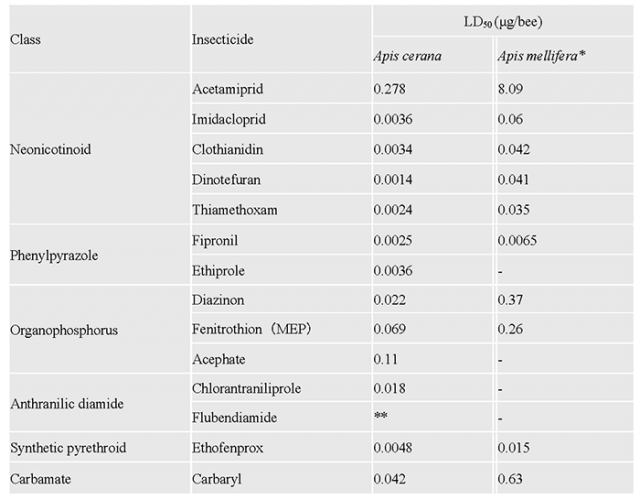Home > Research > Research Results > Research Results 2017 > Newly revealed sensitivity of the Japanese honeybee to various insecticides —establishment of a toxicology testing method―
Update:September 25, 2017
Main content starts here.
Newly revealed sensitivity of the Japanese honeybee to various insecticides —establishment of a toxicology testing method―
| Article title |
(1) Insecticide susceptibility in Asian honey bees (Apis cerana (Hymenoptera: Apidae)) and implications for wild honey bees in Asia (2) Acute contact toxicity of three insecticides on Asian honeybees Apis cerana |
|---|---|
| Author (affiliation) |
(1) Mika Yasuda (a), Yoshiko Sakamoto (b), Koichi Goka (b), Teruyoshi Nagamitsu (c), Hisatomo Taki (a) (2) Mika Yasuda (a), Taro Maeda (d), Hisatomo Taki (a) (a) Department of Forest Entomology, FFPRI, Tsukuba, Ibaraki, Japan (b) National Institute for Environmental Studies, Tsukuba, Ibaraki, Japan (c) Hokkaido Research Center, FFPRI, Sapporo, Hokkaido, Japan (d) National Agriculture and Food Research Organization (NARO), Tsukuba, Ibaraki, Japan |
| Publication Journal |
(1) Journal of Economic Entomology, 110 (2):447-452, April 2017, DOI: 10.1093/jee/tox032( External link ) (2) Bulletin of the Forestry and Forest Products Research Institute, 16 (3):143-146, September 2017 |
| Content introduction |
Honeybees are a group of insects belonging to the genus Apis. They are ecologically and economically important, as they pollinate plants and are used to produce honey in apiculture. In recent years, concerns have been raised over the use of neonicotinoid insecticides, which may have adverse effects on honeybees. In response, many research efforts are being undertaken worldwide to investigate the problem. However, the majority of such efforts target domesticated western honeybee, and hence, much remains unknown about how these insecticides affect wild species including eastern honeybee and its subspecies (such as Japanese honeybee), which are widely distributed across Asia. In the present study, we successfully developed a dedicated method for performing acute toxicity testing by adjusting the period after honeybees used in the test became imagos. Using this method, we tested the toxicity of 14 different insecticides, including neonicotinoids,phenylpyrazoles, diamides, organophosphorus compounds, pyrethroids, and carbamates. Our results showed that LD50 values (footnote 1) for Japanese honeybees were lower than those for western honeybees, indicating that the former die at lower concentrations than the latter. In particular, LD50 values of the five neonicotinoids showed up to a 200-fold difference, indicating that toxicity may greatly differ among different agents even when they belong to the same class of compounds. These results suggest that different approaches toward insecticide risk management are necessary for wild Japanese honeybees as opposed to domesticated western honeybees and that one should not assume that different insecticides based on the same class of compounds exhibit the same toxicity.
Footnote 1) LD50 denotes “50% lethal dose.” It represents the dose at which half of the organisms die and is used as an index of acute drug toxicity. In the present study, it was defined as the concentration at which 50% of the bees died within 48 h.
Photo. Japanese honeybees receiving a test insecticide on the back.
Table. a list of LD50 values of different insecticides for Japanese and western honeybees (in 48 h)
* The values for Western honeybees were cited from previous reports. ** The LD50 value of flubendiamide was not confirmed because no bees died after administration at a dose of 100 μg/bee.
|
Copyright © Forest Research and Management Organization. All rights reserved.


